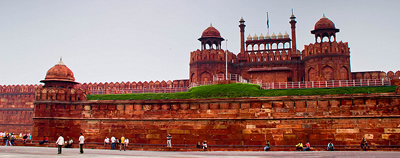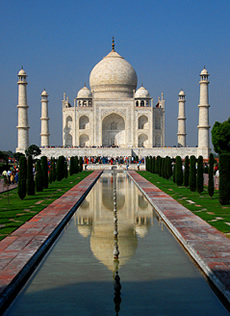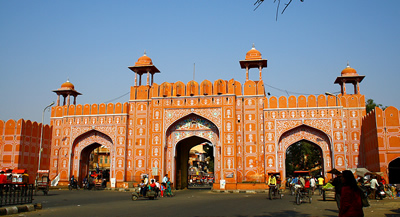World History
Delhi, now the capital of India, has been the political center of Indian civilization for over a thousand years. The settlement known as Indraprastha, which was mentioned in the Indian epic the Mahabharata, was located at modern-day Purana Qila, near Delhi.
It became the capital of Muslim dynasties of Turkish, Afghan, and slave origins that invaded and ruled northern India beginning in the 12th century. Because of its strategic importance at the confluence of the Ganges and Jumna Rivers, it was the battleground of successive conquering armies.
The most ferocious invader was Timurlane (Tamerlane), who laid waste to city and killed or enslaved most of its inhabitants in 1398. Two regional Muslim dynasties rebuilt Delhi after Timurlane left India in 1399, the second being the Lodi dynasty, which was destroyed by Babur at the Battles of Panipat in 1526. Babur made Delhi and Agra his capitals.
Although Babur only reigned from 1526 until 1530, his reign was important because of the impact it had on India in succeeding centuries. He was descended from Timur on his father’s side, and Genghis Khan on his mother’s. He ran much of his administration from Delhi and began to rebuild it.
Babur was buried in Afghanistan but his son Humayun was buried in Delhi. His tomb is an early example of Mughal (or Moghul) architecture, which reached its peak under Humayun’s great-grandson Shah Jahan.
In 1556, Babur’s grandson, Akbar, became emperor and he decided to move the capital from Delhi to Agra, where Babur had begun building palaces and gardens befitting a capital. From 1571 until 1585, Akbar mainly ruled in Fatehpur Sikri. Foreign visitors, including ambassadors from European countries, commented on the opulence of Akbar’s court and the beauty of Agra.
Akbar’s successor Jahangir (ruled 1605–27) held court at Agra, where he received Sir Thomas Roe, the ambassador of James I of England, but for most of his reign Jahangir resided in Lahore in modern-day Pakistan, or in Kabul in Afghanistan. Only a few important buildings were added to Agra during Jahangir’s reign.
Jahangir’s son Shah Jahan was a great builder who greatly added to both Agra and Delhi. His greatest legacy is the Taj Mahal, a great mausoleum he built for his wife, Mumtaz Mahal. It is one of the wonders of the world.
Shah Jahan also built and improved many monuments in Delhi that include large city walls with grand gates, most notably the Ajmeri Gate, the Delhi Gate, the Kashmiri Gate, and the Turkman Gate. Shah Jahan in 1648 began work on the Red Fort in Delhi to improve the city’s defenses.
In 1739, Nadir Shah, emperor of Persia, captured and looted Delhi, taking the fabulous jewel-encrusted Peacock Throne back with him to Persia. In 1760, the Marathas attacked and looted Delhi again. In 1761, the Jats captured Agra and sacked the city, including the Taj Mahal. Nine years later it was captured by the Marathas, who held it until 1803, when both cities were taken by the British.
- Delhi Sultanate
Delhi Sultanate under various dynasties The influx of Muslim Turks into the Indian subcontinent began in the 11th and 12th centuries. It was spearheaded by a series of military dynasties, including the Ghaznavids, who ruled parts of Persia and invaded...
- Babur - Mughal Dynastic Founder
Babur - Mughal Dynastic FounderBabur was descended from Timerlane on his father’s side and Genghis Khan on his mother’s. Son of a petty ruler of Ferghana in Central Asia, he conquered Afghanistan, then northern India, founding the long-lived...
- Mughal Empire
Mughal Empire The Mughal Empire in India was founded by Babur, also known as Zahir-ud-din Mohammed, born in 1482 in Ferghana in Central Asia, a descendant of Timurlane. With Central Asia in turmoil in 1501, Babur fled his native Ferghana and gained the...
- Shah Jahan - Mughal Emperor
Shah Jahan - Mughal EmperorMughal emperor Jahangir’s death and the following succession struggle ended in the triumph of his son, Prince Khurram, who took the title Shah Jahan, which means “emperor of the world.†He killed his male...
- Taj Mahal
Taj Mahal There are very few buildings in the world more famous than the Taj Mahal, a queen’s mausoleum in Agra, India. The sense of romance that the Taj Mahal invokes was developed as a result of British fascination with this structure during...
World History
Delhi and Agra
 |
| Red Fort in Delhi |
Delhi, now the capital of India, has been the political center of Indian civilization for over a thousand years. The settlement known as Indraprastha, which was mentioned in the Indian epic the Mahabharata, was located at modern-day Purana Qila, near Delhi.
It became the capital of Muslim dynasties of Turkish, Afghan, and slave origins that invaded and ruled northern India beginning in the 12th century. Because of its strategic importance at the confluence of the Ganges and Jumna Rivers, it was the battleground of successive conquering armies.
The most ferocious invader was Timurlane (Tamerlane), who laid waste to city and killed or enslaved most of its inhabitants in 1398. Two regional Muslim dynasties rebuilt Delhi after Timurlane left India in 1399, the second being the Lodi dynasty, which was destroyed by Babur at the Battles of Panipat in 1526. Babur made Delhi and Agra his capitals.
  |   |
Although Babur only reigned from 1526 until 1530, his reign was important because of the impact it had on India in succeeding centuries. He was descended from Timur on his father’s side, and Genghis Khan on his mother’s. He ran much of his administration from Delhi and began to rebuild it.
Babur was buried in Afghanistan but his son Humayun was buried in Delhi. His tomb is an early example of Mughal (or Moghul) architecture, which reached its peak under Humayun’s great-grandson Shah Jahan.
 |
| Taj Mahal in Agra |
Akbar’s successor Jahangir (ruled 1605–27) held court at Agra, where he received Sir Thomas Roe, the ambassador of James I of England, but for most of his reign Jahangir resided in Lahore in modern-day Pakistan, or in Kabul in Afghanistan. Only a few important buildings were added to Agra during Jahangir’s reign.
Jahangir’s son Shah Jahan was a great builder who greatly added to both Agra and Delhi. His greatest legacy is the Taj Mahal, a great mausoleum he built for his wife, Mumtaz Mahal. It is one of the wonders of the world.
Shah Jahan also built and improved many monuments in Delhi that include large city walls with grand gates, most notably the Ajmeri Gate, the Delhi Gate, the Kashmiri Gate, and the Turkman Gate. Shah Jahan in 1648 began work on the Red Fort in Delhi to improve the city’s defenses.
In 1739, Nadir Shah, emperor of Persia, captured and looted Delhi, taking the fabulous jewel-encrusted Peacock Throne back with him to Persia. In 1760, the Marathas attacked and looted Delhi again. In 1761, the Jats captured Agra and sacked the city, including the Taj Mahal. Nine years later it was captured by the Marathas, who held it until 1803, when both cities were taken by the British.
 |
| Ajmeri Gate in Delhi |
- Delhi Sultanate
Delhi Sultanate under various dynasties The influx of Muslim Turks into the Indian subcontinent began in the 11th and 12th centuries. It was spearheaded by a series of military dynasties, including the Ghaznavids, who ruled parts of Persia and invaded...
- Babur - Mughal Dynastic Founder
Babur - Mughal Dynastic FounderBabur was descended from Timerlane on his father’s side and Genghis Khan on his mother’s. Son of a petty ruler of Ferghana in Central Asia, he conquered Afghanistan, then northern India, founding the long-lived...
- Mughal Empire
Mughal Empire The Mughal Empire in India was founded by Babur, also known as Zahir-ud-din Mohammed, born in 1482 in Ferghana in Central Asia, a descendant of Timurlane. With Central Asia in turmoil in 1501, Babur fled his native Ferghana and gained the...
- Shah Jahan - Mughal Emperor
Shah Jahan - Mughal EmperorMughal emperor Jahangir’s death and the following succession struggle ended in the triumph of his son, Prince Khurram, who took the title Shah Jahan, which means “emperor of the world.†He killed his male...
- Taj Mahal
Taj Mahal There are very few buildings in the world more famous than the Taj Mahal, a queen’s mausoleum in Agra, India. The sense of romance that the Taj Mahal invokes was developed as a result of British fascination with this structure during...
